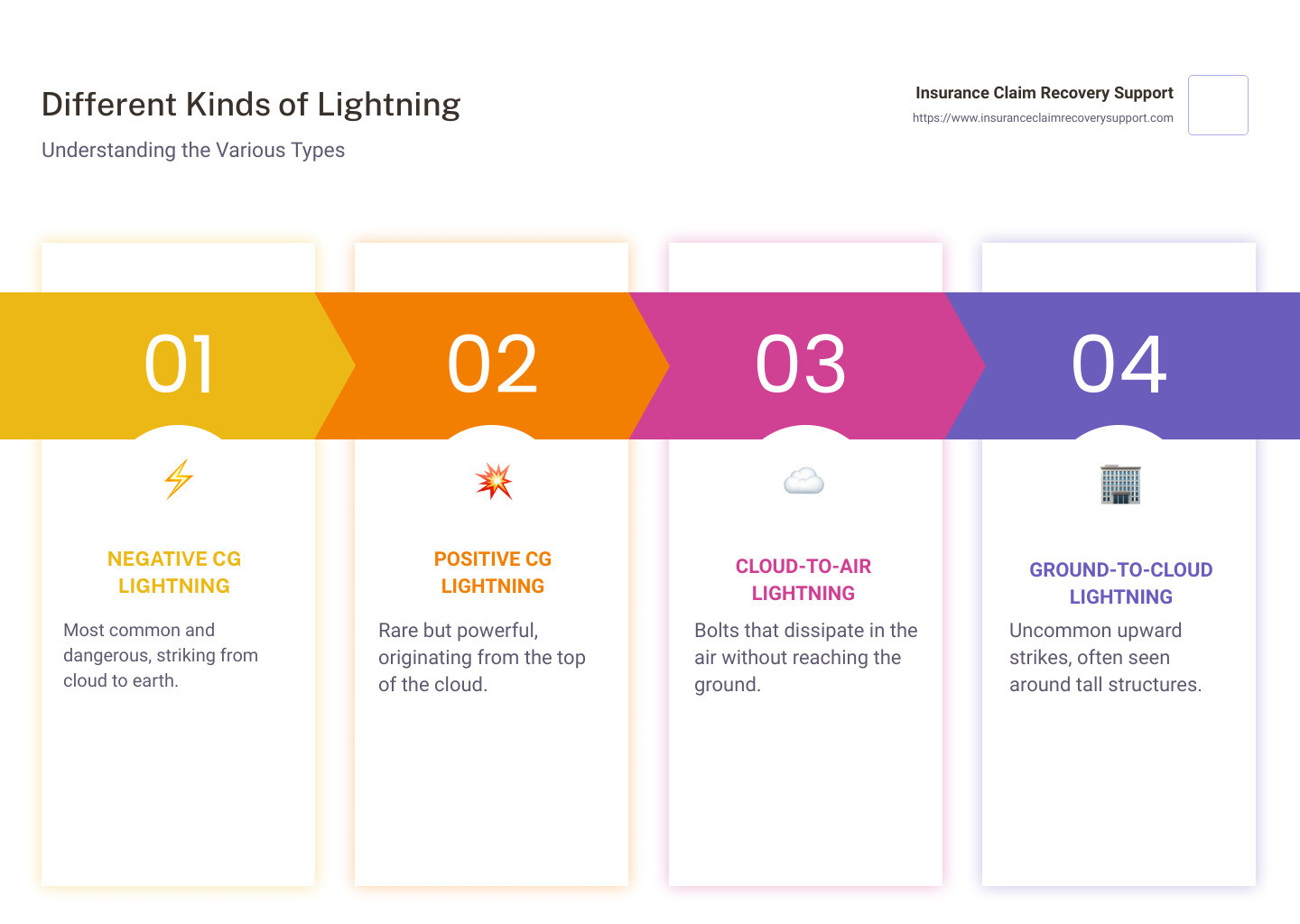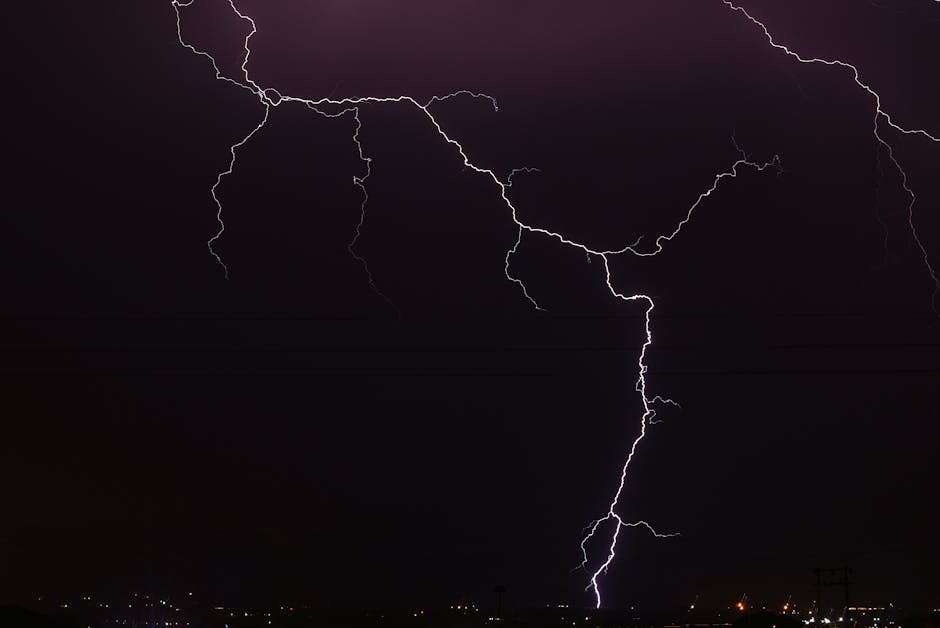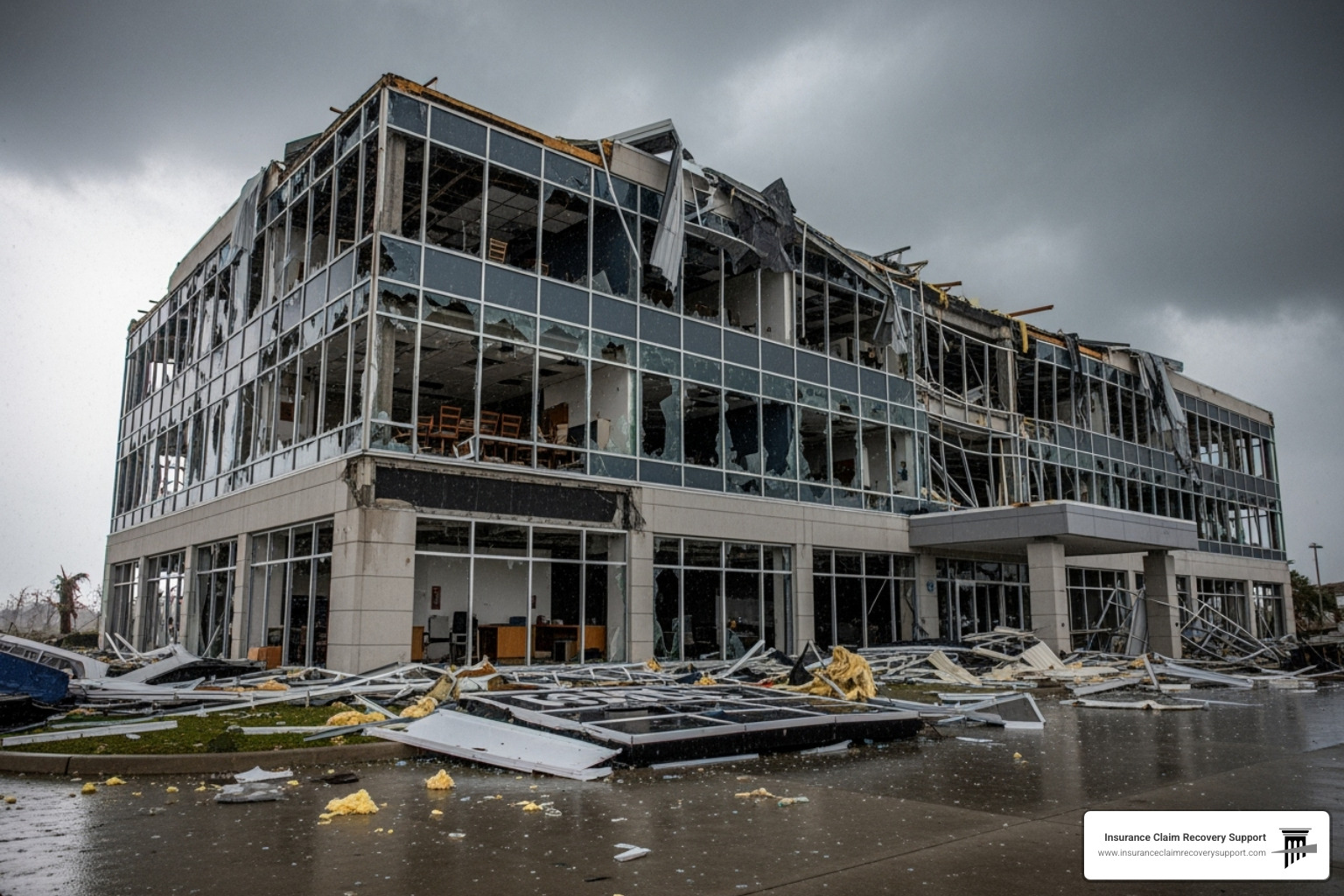A Flash of Insight: Different Kinds of Lightning
When we think of lightning, we often picture a dramatic streak of light cutting through the sky, but different kinds of lightning exist, each with unique characteristics and risks. Let’s explore them quickly:
- Negative Cloud-to-Ground Lightning: Most common and dangerous, striking from cloud to earth.
- Positive Cloud-to-Ground Lightning: Rare, but powerful, originating from the top of the cloud.
- Cloud-to-Air Lightning: Bolts that dissipate in the air without reaching the ground.
- Ground-to-Cloud Lightning: Uncommon upward strikes, often seen around tall structures.
- Intracloud Lightning: Frequent within a single cloud, often called “sheet lightning.”
- Cloud-to-Cloud Lightning: Flickers between different clouds, creating spectacular displays.
Understanding these types is crucial, especially considering both the beauty and danger of lightning. Whether you’re a property owner or involved in any of a multitude of industries, knowing the various forms of lightning and their potential impacts can help you prepare and protect your assets.
I’m Scott Friedson, a multi-state licensed public adjuster, with a proven track record in managing lightning damage claims. Over my career, I have successfully settled hundreds of large loss claims, ensuring policyholders receive a fair settlement.

The Science Behind Lightning
Understanding lightning starts with the basics of how it forms, how charges accumulate, and the discharge process. Let’s break it down.
Formation
Lightning forms in thunderstorms, where warm, moist air rises rapidly, leading to the creation of cumulonimbus clouds. Inside these clouds, turbulent air currents cause water droplets and ice particles to collide and interact, creating an electric charge.
Charge Accumulation
As these particles collide, they transfer charges. Typically, lighter ice crystals gain positive charges and are pushed to the top of the cloud, while heavier, negatively charged particles settle at the bottom. This separation of charges creates a strong electric field within the cloud.

Discharge Process
Once the electric field becomes strong enough, a discharge occurs to neutralize the charge difference. This discharge is what we see as lightning. There are several types of lightning discharges, each with its own characteristics.
-
Step Leader Formation: The discharge process begins with a step leader, a channel of ionized air that moves downward from the cloud in steps, each about 50 meters long.
-
Return Stroke: When the step leader nears the ground, it attracts positive charges from the surface. These positive charges shoot up, meeting the step leader. This connection creates a return stroke, a bright flash of light that travels back up to the cloud.
-
Multiple Strokes: Often, a single lightning bolt consists of multiple strokes, creating the flickering effect we sometimes see.
By understanding these fundamental aspects of lightning formation, charge accumulation, and the discharge process, we can better appreciate the various forms of lightning and their potential impacts on our lives and properties.
Next, we’ll delve into the different kinds of lightning strikes, exploring their unique characteristics and why they matter.
Different Kinds of Lightning Strikes
Lightning is a fascinating and complex natural phenomenon. Each type of lightning has unique characteristics and behaviors. Understanding these can help us better appreciate their beauty, as well as their potential dangers.
Cloud-to-Ground (CG) Lightning
Cloud-to-Ground (CG) Lightning is the most well-known type. It occurs when a channel of negative charge, called a stepped leader, travels from the cloud to the ground. This is often referred to as forked lightning due to its branching appearance.
Negative CG Lightning
The most common type of CG lightning is Negative CG Lightning. This involves a negatively charged leader making contact with a positively charged streamer from the ground. When they connect, a bright flash, known as the return stroke, travels back up to the cloud. Negative CG strikes are known for their distinctive branching patterns.
Positive CG Lightning
Less common but more powerful is Positive CG Lightning. Here, a positively charged leader descends from the cloud. Positive CG strikes are typically very bright and lack the branching seen in negative CG strikes. They are often associated with supercell thunderstorms and can produce loud, low-frequency thunder.
Intracloud (IC) Lightning
Intracloud (IC) Lightning occurs within a single cloud. This is the most common form of lightning and happens when different charge regions in the cloud discharge. IC lightning is often referred to as sheet lightning when it illuminates the entire cloud, creating a glowing sheet of light.
Sheet Lightning and Heat Lightning
Sheet Lightning is a term used when the lightning channel is hidden by clouds, making the flash appear as a sheet of light. Heat Lightning is similar but occurs too far away for the thunder to be heard. It’s commonly seen on hot summer nights.
Cloud-to-Cloud (CC) Lightning
Cloud-to-Cloud (CC) Lightning, also known as intercloud lightning, occurs between different clouds. This type of lightning can travel horizontally across the sky. An interesting subtype is Spider Lightning, which moves horizontally across the underside of clouds, creating a web-like appearance.
Cloud-to-Air (CA) Lightning
Cloud-to-Air (CA) Lightning occurs when a discharge jumps from a cloud into the clear air. These discharges often terminate abruptly and are sometimes seen as bright channels extending from the sides of cumulonimbus clouds. CA lightning often accompanies CG lightning as branches extend into the air.
Ground-to-Cloud (GC) Lightning
Ground-to-Cloud (GC) Lightning is an upward-moving discharge that originates from an object on the ground, such as a tall building or tower. These strikes can be either positive or negative in polarity. GC lightning is often seen in urban areas with many tall structures. Upward strikes are characterized by upward branching, indicating the direction of the discharge.
By understanding these different kinds of lightning, we can better appreciate their unique behaviors and the various ways they impact our environment. Next, we’ll explore some rare and powerful lightning phenomena that push the boundaries of what we know about this incredible natural force.
Rare and Powerful Lightning Phenomena
When it comes to lightning, some phenomena are so rare and powerful that they push the boundaries of our understanding. Let’s dive into these extraordinary forms of lightning: Superbolts, Gigantic Jets, and Transient Luminous Events like Sprites, Blue Jets, and Elves.
Superbolts
Superbolts are not your average lightning strikes. These are incredibly intense flashes that can be up to 1,000 times more powerful than typical lightning. They are rare, accounting for less than 0.01% of all lightning strikes.
Intensity and Damage Potential:
– Intensity: Superbolts can reach an astonishing 100 gigawatts of power.
– Damage Potential: Due to their immense energy, superbolts can cause significant damage to electrical systems, start large fires, and even affect satellites in orbit.
Gigantic Jets
Gigantic Jets are another rare type of lightning that shoots upwards from the top of thunderstorms, reaching altitudes of up to 50 miles. They are sometimes called “space lightning” due to their high-altitude occurrence.
Rarity and Power:
– Rarity: Gigantic Jets are extremely rare, with only a few dozen documented cases.
– Power: These jets can transfer a large amount of electrical charge from the cloud to the ionosphere, making them powerful and awe-inspiring.
Sprites, Blue Jets, and Elves
Sprites, Blue Jets, and Elves are collectively known as Transient Luminous Events (TLEs). These occur high in the Earth’s atmosphere and are rarely seen by the naked eye.
Sprites
Sprites are large, weak discharges that occur above thunderstorms. They are usually red and can extend up to 60 miles from the cloud top.
Visual Characteristics:
– Shapes: Sprites often resemble columns, carrots, or jellyfish.
– Duration: They last only a few milliseconds, making them difficult to observe without specialized equipment.
Blue Jets
Blue Jets emerge from the tops of thunderclouds and shoot upwards in a narrow cone shape, reaching heights of 25-35 miles.
Visual Characteristics:
– Color: As their name suggests, Blue Jets are blue in color.
– Duration: They last just a fraction of a second but are bright enough to be seen by pilots and sometimes from the ground.
Elves
Elves are the fastest and largest of the TLEs, occurring above thunderstorms in the ionosphere. They appear as rapidly expanding disk-shaped regions of glowing light, up to 300 miles across.
Visual Characteristics:
– Color: Elves are usually red and very faint.
– Duration: They last less than a thousandth of a second, which makes them incredibly hard to spot.
Understanding these rare and powerful lightning phenomena not only deepens our appreciation of nature’s complexity but also highlights the need for further research. These events remind us that there is still much to learn about the forces that shape our world.
Next, we will discuss essential lightning safety tips to keep you and your property safe during thunderstorms.
Lightning Safety Tips
Staying safe during thunderstorms is crucial. Here are some essential tips to help you:
Indoor Safety
-
Stay Indoors:
The safest place during a thunderstorm is inside a sturdy building. Avoid small sheds or standalone structures. -
Keep Away from Windows:
Windows can shatter during a storm due to strong winds or hail. Stay in interior rooms away from windows to avoid injury. -
Avoid Electrical Equipment and Plumbing:
Do not use wired electronic devices such as desktop computers or gaming consoles. Lightning can travel through electrical systems. Similarly, avoid activities like bathing or washing dishes, as plumbing can also conduct electricity from a lightning strike.
Avoiding Open Areas
-
Do Not Shelter Under Trees:
Trees are common lightning targets. If you are caught outside and cannot reach a safe building, avoid standing under trees or other tall isolated objects that can attract lightning. -
Stay Off Elevated Areas:
Hills, mountain ridges, and other elevated areas make you more susceptible to lightning strikes. Move to lower ground if you are outdoors during a storm. -
Avoid Large Metal Objects:
Do not touch or be near large metal objects like fences or poles, which can conduct electricity.
Post-Storm Precautions
-
Check for Damage:
Once the storm has passed, inspect your property for any signs of damage. This includes checking for fallen branches, damage to the roof, or signs of fire. -
Smell for Gas:
If you detect the odor of gas or hear a hissing noise, leave the area immediately and contact your gas company. Do not turn on lights or use anything that could ignite a spark. -
Inspect Electrical Appliances:
If you suspect any of your electrical systems have been affected, have a licensed electrician inspect them before turning the power back on to prevent further damage.
By following these guidelines, you can enhance your safety during a thunderstorm. Preparation and knowledge are key.
Next, we’ll address some frequently asked questions about lightning to clear up common concerns and misconceptions.
Frequently Asked Questions about Lightning
What is the rarest type of lightning?
The rarest type of lightning is ball lightning. This phenomenon appears as a glowing sphere that moves erratically and lasts for several seconds. Despite numerous eyewitness accounts, it remains poorly understood and is the subject of ongoing scientific research.
Another rare form is sprites, which are electrical discharges that occur high above thunderstorms. Sprites appear as vertical red columns and are only visible at night, making them nearly invisible to the naked eye.
What is the strongest lightning called?
The strongest lightning strikes are called superbolts. These bolts are up to 1,000 times more powerful than typical lightning strikes. Superbolts can cause significant damage due to their immense energy and are often associated with severe thunderstorms. They can be identified by their extreme brightness and the loud, booming thunder that follows.
How can lightning affect property?
Lightning can cause various types of property damage, including:
- Fire Damage: A direct strike can ignite fires, especially if it hits the roof or other flammable materials.
- Electrical Surge Damage: Lightning can cause power surges that fry circuits and damage electronics, appliances, and wiring.
- Structural Damage: The intense energy from a strike can create holes in roofs or walls and cause structural weakening.
- Damage to Personal Property: Items like computers, TVs, and other electronics are particularly vulnerable to the electromagnetic pulse generated by a lightning strike.
Understanding these risks can help you take steps to protect your property and ensure you have the right insurance coverage to handle potential lightning damage.
Next, we’ll delve into some practical lightning safety tips to keep you and your property safe during thunderstorms.
Conclusion
Navigating the aftermath of a lightning strike can be daunting. At Insurance Claim Recovery Support, we understand the complexities involved in filing a lightning insurance claim and are dedicated to guiding you through every step of the process.
Insurance Claim Recovery Support
When lightning strikes, the damage can be extensive and overwhelming. We’re here to help you navigate the challenging process of filing a claim and ensuring you get the compensation you deserve. Our team of experts specializes in interpreting policies and negotiating claims, so you don’t have to face the stressful details alone.
Maximizing Settlements
Our goal is to ensure you receive a fair settlement that fully covers the damage to your property. We meticulously assess the damage and fight for a claim that reflects the true cost of repairs and replacements. Our proactive approach minimizes the risk of claim denial and maximizes your potential for a favorable resolution.
Advocacy for Policyholders
At Insurance Claim Recovery Support, we do more than process claims. We advocate for your rights, ensuring that your insurance company honors its obligations. When you face the challenge of a lightning strike, you’re not alone. We’re here to light the way to recovery.
For more information on how we can assist you with your lightning insurance claim, please visit our service page.
Together, we can turn a challenging situation into a successfully resolved claim, ensuring that your property is restored and your financial interests are protected. Trust us to be your advocates in navigating the storm.







